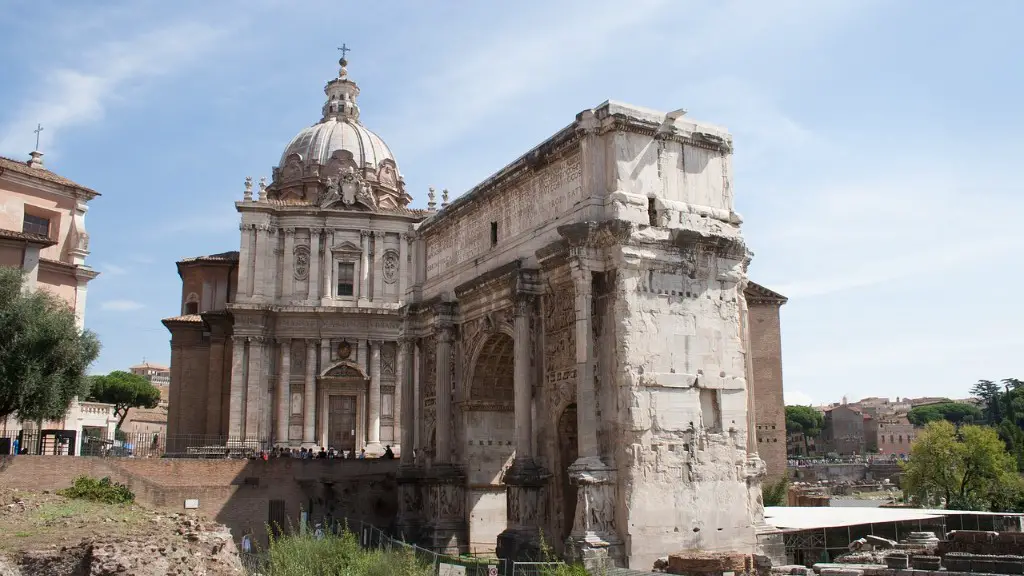The Ancient Romans lived through many hardships, including illness. They endured a great deal of pain and debilitating illnesses during their lifetimes. Throughout history, new diseases have found ways to infiltrate the population. This article will explore the common illnesses of Ancient Rome, delve into the treatments and remedies of the time and discuss the unique healthcare that was prevalent in the period.
In the first centuries of Ancient Rome, healthcare was rudimentary. Medical technology and knowledge of illnesses were limited at this time. As a result, illness was very common in ancient Rome. Fever, skin problems, respiratory and diarrheal illnesses, mental disorders and many other diseases ran rampant in the city. Many illnesses were treated symptomatically, by attempting to relieve the associated symptoms. However, as time went on, treatments and medicines began to emerge that actually targeted the illnesses.
The two main forms of medicine were herbalism and surgery. Herbalism was an ancient form of medicine where herbs and other natural ingredients were mixed together to create a remedy. Herbal remedies were believed to help the body heal through natural processes. Surgery on the other hand was used to treat severe and life threatening conditions, such as tumours, injuries and abscesses. Ancient Roman surgeons were skilled in their profession and could even perform complex operations such as amputations and tracheotomies.
Apart from more traditional treatments and medicines, the Ancient Romans also employed various forms of ritual and superstitious healing as well. These practices included animal sacrifices, chanting, use of precious stones and even spellcasting. Interestingly, some of these practices were adopted by the Christian Church and have evolved over time to form modern day healing techniques such as prayer and the laying on of hands.
The Ancient Romans also placed a great deal of importance on health and cleanliness. The aqueduct system that was constructed during this period was integral in providing the city with fresh water, which greatly helped in reducing the rate of contagious illnesses. Romans were also known to bathe in hot springs and were seen as being obsessed with body hygiene.
Lastly, it is important to note that the Ancient Romans did not have access to the same level of sanitary precautions that we have today. Without antibiotics and proper sanitation, the death rate was very high and illnesses, such as malaria, ran rampant in the population. This had a huge impact on the health and life expectancy of the Roman people.
Health in the Roman Empire
Health in the Roman Empire was of great importance. With the rise of a new urban infrastructure, it soon became evident that improved public health was needed to support the booming population. The Roman government began to impose laws that required cities to remain clean and hygienic. This was in order to minimize the spread of diseases such as malaria, dysentery and typhoid.
The Roman government also funded medical research. This provided physicians with resources to study and research illnesses and readied them to develop treatments and remedies. Some famous figures during this period were Galen and his discoveries in anatomy, Hippocrates and his famed oath which prescribed ethical principles for medical practice and Celsus who written one of the most authoritative medical texts at the time.
Roman citizens also paid for their own health care, typically with coins. This enabled individual citizens to seek medical attention without needing to rely on the state. In this way, Roman healthcare became an extremely market driven system, albeit with a great deal of government oversight.
The Roman Empire eventually fell in 476 AD and many of the health care systems and advancements of the era were lost. However, due to the detailed records of ancient Roman life that have been kept, many of their treatments, practices and principles have endured.
Prevalence of Disease
In ancient Rome, disease was rampant. The medical knowledge was limited, leaving citizens at a high risk of illness. Poor hygiene, stagnant water and over-crowding were all contributing factors to the spread of disease. The two most common illnesses during the ancient Roman period were malaria and dysentery.
Malaria was endemic to the region, primarily due to the climate and mosquitoes. It was believed that up to 25% of the population of Rome was infected with malaria. It was an extremely debilitating illness, often causing fever, fatigue and other symptoms. Dysentery was also common, being caused by contaminated water and food. The infection caused diarrhea, dehydration and general malnourishment. Both malaria and dysentery were difficult to treat and often caused further damage to the Roman population’s health.
Apart from malaria and dysentery, various other illnesses plagued the ancient Roman era. Smallpox, tuberculosis, leprosy, rickets and even the plague were all present in ancient Rome. Most of these diseases were difficult to diagnose and treat and many citizens did not survive the illnesses.
Health Care Practices
The health care system of ancient Rome revolved around the concept of natural healing. This is defined as the idea that the human body has the capacity to heal itself through natural processes, with the use of herbs, medications and other natural remedies. This was a popular form of medicine during the Roman Empire and was often used to great effect in treating illnesses.
Another popular form of health care was the use of public baths. This allowed citizens to clean themselves and reduce the risk of contagion. The baths also served as a form of relaxation and social gatherings. Lastly, the practice of aspersion was prevalent during this era. This practice entailed throwing water on a person, either as a form of celebration or as a religious ritual.
Apart from these practices, the Roman Empire had a wealth of medicinal knowledge. Physicians and medical practitioners of the day were prepared to carry out complex operations and diagnoses. They would diagnose illnesses based on the patient’s symptoms, interpret medical texts and prescribe treatments and medications to their patients.
Public Perception
The people of ancient Rome were accustomed to illness. As such, they developed their own general attitude towards health and illness. Mental illnesses, such as depression, were not given much importance as it was believed that these illnesses were due to spiritual afflictions or evil curses. Conversely, physical illnesses, such as fever or dysentery, were seen as a form of punishment for moral transgressions.
The Romans also assumed that certain illnesses were caused by the gods and the heavens. This was especially the case with epidemics such as smallpox or the plague. When these illnesses ravaged the population, it was believed that the gods had sent them to punish the people for their wickedness. People were sometimes accused of sorcery, as a belief in witchcraft was also present.
The Romans also believed that health was a sign of social standing. Wealthier citizens were able to afford better and more frequent treatments and, as such, had better health and lives. Poorer citizens, on the other hand, were more likely to suffer the consequences of the illnesses.
Death and Mortality
Due to the lack of medical knowledge and treatments, the death rate in ancient Rome was extremely high. Infant mortality was especially high, with estimates suggesting that up to 50% of infants did not survive past their first year. Life expectancy was typically between 30-50 years, depending on the individual’s social standing.
Death was a part of everyday life in ancient Rome. Many tombs and burial sites can still be seen from this era, indicating the prevalence of death in this period. People were buried in cremation sites, stone sarcophagi or in catacombs. Funerals were also an important part of Roman culture and the dead were traditionally mourned for nine days.
All in all, illnesses were a common occurrence in ancient Rome and the Roman physicians of the time did their best to treat the sick. Even though medical knowledge was limited, many of their treatments, remedies and practices endured and can still be found today in various forms.





